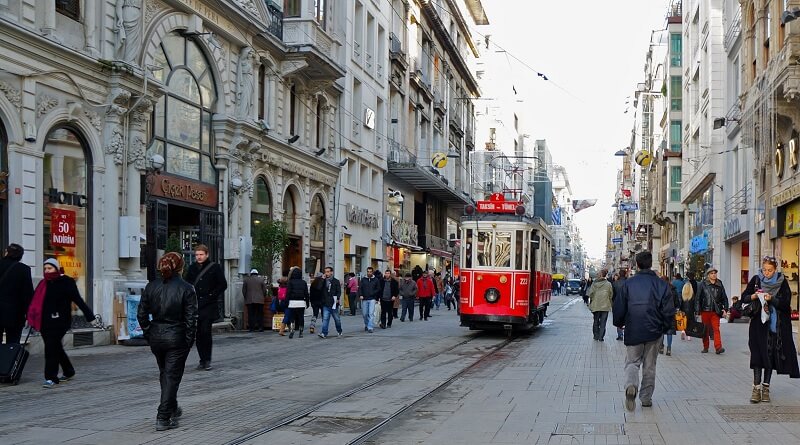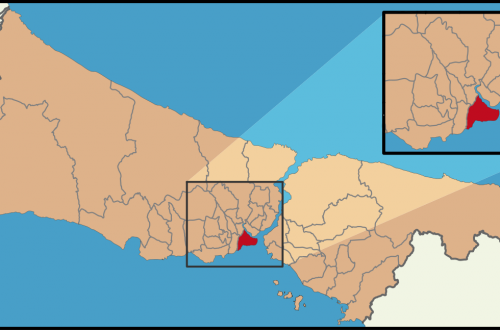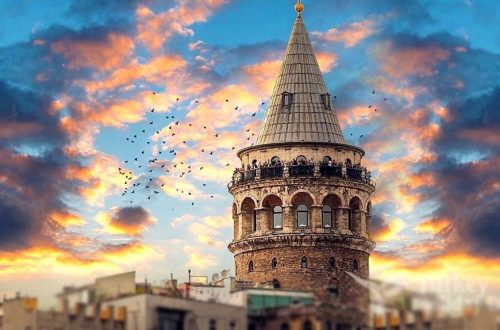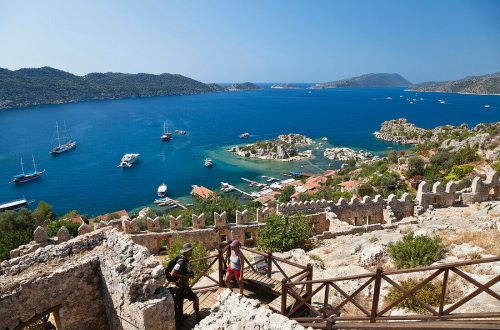
Istiklal Caddesi
Istiklal Caddesi: Istanbul’s famous boulevard
The Istiklal Caddesi, in its old name: “Grande Rue de Pera“, is the great boulevard of Istanbul.
The street stretches from Taksim Square in the north to the Galata Tower in the south – parallel to the Bosporus.
The Istiklal Caddesi is flanked by sights, boutiques, shopping centres and bars.
Is the Istiklal Caddesi worth visiting?
Istiklal Caddesi is featured in all the Istanbul travel guides.
Istiklal Caddesi is symbolised by the red trams that connect the north and south ends of the street. The trams are also one of Istanbul’s many landmarks.
There must be something interesting about Istiklal Caddesi.
So what is there to see on and off the road?
The southern end of Istiklal Caddesi begins near the Galata Tower and the Tünel. The red tram goes from there to the north end of Istiklal Caddesi, on Taksim Square.
There are all kinds of buildings between the approximately 1.5 km long tram route:
Magnificent buildings from the 19th century, in which embassies were housed, are all lined up:
Modern shopping malls, Islamic monasteries, Catholic churches, theatres, food stalls, party rooms, clubs and boutiques.
The restaurants and snack bars are attractive with typical food from Istanbul and Turkey.
These include the typical Simit sellers and Turkish ice cream parlours, as well as restaurants with several stars.
The boulevard is changing
Unfortunately, the same thing is happening on the Istiklal as on all the boulevards in the world:
The small shops are being displaced by the big fashion houses and fast-food chains. The rents are rising, the old-established shops are closing and the original charm of the street is slowly being lost.
This is precisely why it pays to visit Istiklal Caddesi in its current form. For the time being, it still corresponds to its “old self”.
For now, there are just a few large department stores, a few Mc Donald’s and not too many Starbucks branches.
Sights are hidden on the side streets
Istiklal Caddesi runs through the Beyoglu district. For centuries, it has been a testament for diversity.
This can be seen, for example, in the Istanbul Mevlana Dervish House. It belonged to the order of the Islamic Sufi Dervish.
It is now a museum.
In the evening there will be performances of the “Whirling Dervishes” in the Dervish House.
There is a Catholic church located just a few meters from the Dervish House.
A little further down the road, you will find the Istanbul Jewish Museum and a Greek Orthodox Church.
All of its structures are much older than 100 years. Beyoglu – formerly Galata, has always been the part of Istanbul where different cultures met and understood each other.
The Beyoglu district has had many names throughout history.
One was Galata; another name was Pera.
In the days of ancient Constantinople Pera was the district where the Greeks lived.
They made up 10% of the population of Istanbul until the end of the Ottoman Empire.
Then came the Turkish-Greek War, which lasted until 1923 …
… and later, the conflict over Cyprus. What remained are a few thousand Greeks who still live in or around Beyoglu.
Beyoglu is constantly changing.
That was the case 100 years ago and is currently the case again.
In 2000 there were just 5,000 guest beds in the entire district. Today, there are more than 50,000.
Besides that, there are now all the new shops and shopping malls along Istiklal Caddesi.
Night life and food
Beyoglu is the hip district of Istanbul. At night, the bars, clubs and party rooms characterise Istiklal Caddesi and Taksim Square.
The street gets really crowded in the evening.
The street attracts travellers as well as the inhabitants of Istanbul.
There is definitely something for everyone:
Michelin-starred restaurants,
cheap cellar bars,
cosy cafes …
The restaurants in Cicek Pasaji, which opened in 1876, are the classic places to eat along Istiklal Caddesi. The prices in the “Flower Passage”, which translates as Cice Pasaji, are higher than in the surrounding restaurants.
A personal recommendation, in one of the many side streets of Beyoglu, is Cafe Kronotrop. They serve the best flat white coffee and brownies in Istanbul.
Shopping on Istiklal Caddesi
Istiklal Caddesi is a mixture of restaurants, candy shops, …
… small shops and international fashion chains.
The small shops are at the south end of the street.
There are many food stores, Turkish ice cream parlours, candy and souvenir shops in the area.
The larger shops, department stores and fashion chains can be found in the middle of the street.
An ice cream parlour and snack stand in the Istiklal Caddesi pedestrian street in Istanbul
An ice cream parlour and a takeaway shop
The shops are all different:
You can shop in a H&M or a mango …
… or in a brand store from Turkey.
Clubs and bars are hidden on the roofs of the houses or in the basement. The same goes for the side streets.
The bars fill up from 8 p.m. till closing time.
The clubs usually don’t get full until around midnight. They are open until the early hours of the morning.
So is it worth visiting Istiklal Caddesi? The answer is – a resounding YES.
Be sure to visit the Istiklal during a city trip to Istanbul.
It is away from tourist attractions such as the Grand Bazaar or the Blue Mosque, one of the most interesting places in the city.
An alternative for travellers who want to be away from the tourist hustle and bustle is Bagdat Caddesi. It starts on the Asian side of Istanbul – near the Haydapasa train station.
The shops and nightlife on Bagdat Caddesi are very similar to Istiklal Caddesi.
One good thing about Bagdat Caddesi is that the prices are lower, compared to Istiklal Caddesi.
The only thing missing along the Bagdat Caddesi are the interesting buildings on every street corner. They make it worthwhile to take a stroll along the street on Istiklal Cadessi – even if you don’t want to go shopping.
Tip for nightlife on Bagdat Caddesi: The entire street will be filled with feverish sports fans during a home game of Fenerbahce Istanbul.
The same applies to Istiklal Caddesi in connection with a Besiktas Istanbul home game.
Information about the street
How to get there:
To the south end: Karaköy – Beyoglu Tünel or Metro M2 station “Sishane”
To the north end: Kabatas – Taksim Tünel or Metro M2 station “Taksim”
The opening times:
Business during the day: 9 a.m. to 7 p.m. (except Sunday)
Bars and clubs at night: The bars get full from 9pm and the clubs start filling up from 11pm onwards. They are open until the early hours of the morning.
Attractions:
- Cicek Pasaji (Flower Passage): restaurants and cafes
- Mevlana Dervish House (Museum)
- Galata Tower
- Taksim place
- Pera Museum (art museum)
- Hagia Triada (Greek Orthodox Church)
- St. Antonius Basilica (Catholic)
What do you think of Istiklal Caddesi?
Post your tips and thoughts on the epically famous Istanbul street in the comments section below!




